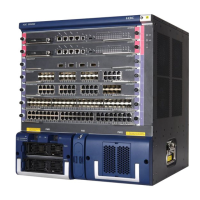defined by the ISO organization for IS-IS routing and extended by IETF RFC 1195 to operate in both TCP/IP and the OSI reference
model (Integrated IS-IS)
Policy-based routing
: makes routing decisions based on policies set by the network administrator
IP performance enhancement
: is a set of tools that enhances the performance of IPv4 networks; includes directed broadcasts,
customization of TCP parameters, support of ICMP error packets, and extensive display capabilities
Unicast Reverse Path Forwarding
(uRPF): is defined by RFC 3704 and limits erroneous or malicious traffic
Static IPv6 routing
: provides simple, manually configured IPv6 routing
Dual IP stack
: maintains separate stacks for IPv4 and IPv6 to ease transition from an IPv4-only network to an IPv6-only
network design
Routing Information Protocol next generation
(RIPng): extends RIPv2 to support IPv6 addressing
OSPFv3
: provides OSPF support for IPv6
IS-IS for IPv6
: extends IS-IS to support IPv6 addressing
BGP+
: extends BGP-4 to support Multiprotocol BGP (MBGP), including support for IPv6 addressing
IPv6 tunneling
: is an important element for the transition from IPv4 to IPv6; allows IPv6 packets to traverse IPv4-only networks
by encapsulating the IPv6 packet into a standard IPv4 packet; supports manually configured, 6to4, and Intra-Site Automatic
Tunnel Addressing Protocol (ISATAP) tunnels
Multiprotocol Label Switching
(MPLS): uses BGP to advertise routes across Label Switched Paths (LSPs), but uses simple labels
to forward packets from any Layer 2 or Layer 3 protocol, thus reducing complexity and increasing performance; supports
graceful restart for reduced failure impact; supports LSP tunneling and multilevel stacks
Multiprotocol Label Switching
(MPLS)
Layer 3 VPN
: allows Layer 3 VPNs across a provider network; uses MP-BGP to establish
private routes for increased security; supports RFC 2547bis multiple autonomous system VPNs for added flexibility
Multiprotocol Label Switching
(MPLS)
Layer 2 VPN
: establishes simple Layer 2 point-to-point VPNs across a provider network
using only MPLS LDPs; requires no routing and therefore decreases complexity, increases performance, and allows VPNs of non-
routable protocols; uses no routing information for increased security; supports Martini draft technologies
Virtual Private LAN Service
(VPLS): establishes point-to-multipoint Layer 2 VPNs across a provider network
Multiprotocol Label Switching Traffic Engineering
(MPLS TE): Traffic Engineering (TE) is used to enhance traffic over large
MPLS networks based on type of traffic and available resources; TE dynamically tunes traffic management attributes and
enables true load balancing; MPLS TE supports route backup using Fast Reroute (FRR)
Service loopback
: allows any module to take advantage of higher-featured modules, including OAA modules, by redirecting
traffic; reduces investment and enables higher bandwidth and load sharing; supports IPv6, IPv6 multicast, tunneling, and MPLS
Bidirectional Forwarding Detection
(BFD): enables link connectivity monitoring and reduces network convergence time for RIP,
OSPF, BGP, IS-IS, VRRP, MPLS, and IRF
Multicast VPN
: supports Multicast Domain (MD) multicast VPN, which can be distributed on separate service cards, providing
high performance and flexible configuration
Security
DHCP protection
: blocks DHCP packets from unauthorized DHCP servers, preventing denial-of-service attacks
DHCP snooping
: helps ensure that DHCP clients receive IP addresses from authorized DHCP servers and maintain a list of DHCP
entries for trusted ports; prevents reception of fake IP addresses and reduces ARP attacks, improving security
RADIUS
: eases switch security access administration by using a password authentication server
TACACS+
: is an authentication tool using TCP with encryption of the full authentication request that provides additional security
Switch management logon security
: can require either RADIUS or TACACS+ authentication for secure switch CLI logon
Media access control
(MAC)
authentication
: provides simple authentication based on a user's MAC address; supports local or
RADIUS-based authentication
Secure Shell
(SSHv2): uses external servers to securely log in to a remote device; with authentication and encryption, it protects
against IP spoofing and plain-text password interception; increases the security of Secure FTP (SFTP) transfers
Attack protection
: protects network from attacks that use a large number of ARP requests by using a host-specific, user-
selectable threshold; provides Address Scanning Attack Prevention, MAC Address Flooding Attack Prevention, and STP Attack
QuickSpecs
HP 9500 Switch Series
Overview
DA - 13773 North America — Version 10 — July 12, 2013
Page 5

